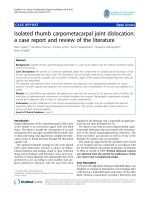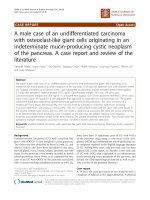báo cáo khoa học: "Sheehan’s syndrome with pancytopenia: a case report and review of the literature" ppt
Bạn đang xem bản rút gọn của tài liệu. Xem và tải ngay bản đầy đủ của tài liệu tại đây (271.38 KB, 3 trang )
CASE REP O R T Open Access
Sheehan’s syndrome with pancytopenia:
a case report and review of the literature
Mnif Fatma, Elleuch Mouna
*
, Rekik Nabila, Mnif Mouna, Charfi Nadia and Abid Mohamed
Abstract
Introduction: Sheehan’s syndrome is defined by varying degrees of anterior pituitary deficiency due to postpartum
ischemic necrosis of the pituitary gland after massive bleeding. It is a rare disorder in western countries and even
in Tunisia. Hematologic abnormalities such as normochromic anemia have been reported in these patients.
However, pancytopenia is rarely observed.
Case presentation: We describe the case of a 48-year-old Tunisian woman with features of hypopituitarism.
Laboratory tests showed pancytopenia that was completely reversed after adequate hormone replacement.
Conclusion: Clinicians should consider the possibility of hypopituitarism as a cause of pancytopenia. This is an
original case report that is of interest to hematologists, who should be aware of Sheehan’s syndrome as a treatable
etiology of pancytopenia for women.
Introduction
Sheehan’s syndrome is characterized by varying degrees
of anterior pituitary dysfunction due to postpartum
ischemic necrosis of the pituitary gland after massive
bleedi ng. The most frequent hematologic finding is ane-
mia. Pancytopenia is rarely observed in patients with
Sheehan’ s syndrome. Only seven cases have been
reported up to now.
Case presentation
A 48-year-old Tunisian woman was urgently sent to our
intensive care department with confusion, vomiting,
abdominal pain and diarrhea. A low blood pressure was
observed (95/65 mmHg). An initial laboratory test showed
hyponatremia at 119 mmol/L and pancytopeni a. Her leu-
kocyte count was 3 × 10
9
/L with a neutrophil count of
1.8 × 10
9
/L. Her hemoglobin level was 7.9 g/dL with mean
corpuscular volume at 87.7fL, mean corpuscular hemoglo-
bin at 32pg and mean corpuscular hemoglobin concentra-
tion at 30 g/dL. Her platelet count was at 92 × 10
9
/L. Her
serum ferritin level was normal at 7.29 ng/mL. A bone
marr ow biopsy revealed hypocellular marrow with hypo-
cellular cell trails. A detailed interview revealed that she
had excessive bleeding in the course of her first delivery at
the age of 22 years. In addition, lactation failed and
menstruation did not resume. She also complained about
generalized weakness. A physical examination showed
pallor and doughy skin. Her breast tissue was normal but
the areolae were depigmented. She had no pubic or axil-
lary hair. Pituitary hormone studies were compatible with
a status of primary pituitary insufficiency (Table 1). In fact
follicle-stimulating hormone was at 3.6 mIU/mL, luteiniz-
ing hormone was at 0.6 mIU/mL and estradiol less than
9 pg/mL. Free thyroxine was lo w at 1.8 pmol/L with an
inadequate level of thyroid-stimulating hormone at
3.9 μU/L. Her basal serum cortisol (measured at 8 a.m.)
was 20 ng/mL, cortisol (measured at 4 p.m.) was at
19.5 ng/mL and cortisol (measured at 11 p.m.) was
18.1 ng/mL. After a s ynacthen stimulation test, cortisol
was at 36 ng/mL. Her prolactin level was 2.8 μg/L. The
diagnosis o f Sheehan’ s syndrome was established and
pituitary magnetic resonance images demonstrated an
empty sella. She received replacement therapy with L-thyr-
oxine 100 μg/day and hydrocortisone 20 mg/day.
Our patient was f ollowed for six weeks after which a
complete hematological recovery was noted, with a eucor-
tisolemic and euthyroid state. In fact, the hematologic
abnormality had dramatically improved. Her leukocyte
count was 6.2 × 10
9
/L, her hemoglobin level was 10 g/dL
and her platelet count was 219 × 10
9
/L, all within the
normal range.
* Correspondence:
Endocrinology Department, Hedi Chaker Hospital, (3029) Sfax, Tunisia
Fatma et al . Journal of Medical Case Reports 2011, 5:490
/>JOURNAL OF MEDICAL
CASE REPORTS
© 2011 Fatma et al; licensee BioMed Central Ltd. This is an Open Access article distributed under the terms of the Creative Commons
Attribution License ( ), which permits unrestricted use, distribution, and reproduction in
any medium, pro vided the original work is properly cited.
Discussion
The diagnosis of Sheehan’ssyndromeisdeterminedbythe
patient’s history and physical examination, and confirmed
by laboratory tests (hormone levels and hormone stimula-
tion tests which prove anterior pituitary failure). Labora-
tory tests can reveal many other anomalies such as
hyponatremia. This is the most common electrolyte imbal-
ance, occurring in 33% to 69% of cases [1,2]. Cortisol defi-
ciency, h ypothyroidism and v olume depletion are the
main causes of hyponatremia. It also seems that Sheehan’s
syndrome has hematological consequences, to which little
attention is paid b ecause of their rarity. Anemia is well
recognized as a feature of hypopituitarism. Gokalp et al.
have recently reported hematological abnormalities in 65
patients with Sheehan’s syndrome, 80% of whom pre-
sented with anemia, compared with 25% of controls [3].
Many hormon al deficien cies, such as hypothyroidi sm,
adrenal insufficiency and gonadal hormonal deficiency,
can explain normochromic anemia in hypopituitarism [4].
On the other hand, it can be the result of a physiologic
adjustment to lower oxygen requirement, as pituitary hor-
mones modulate the production of erythropoietin in the
kidney [5]. The low erythropoietin levels found in these
patients support this argument. However, within the
framework of hematologic disorders, pancytopenia is
rarely observed in patients affected with Sheehan’s
syndrome.
A literature review revealed the rarity of this disorder.
The first case was reported by Ferrari et al. in 1975 [6].
Only seven cases have been reported up to now (Table 1
and Table 2) [5]. The mean age of these women was 41.1
years (range: 22 to 57 years). The mean time between the
hemorrhagic accident and diagnosis was at 11.1 years
(range: two to 27 years) [5,7,8]. Hematologic disorders
were behind the discovery of Sheehan’s syndrome in fo ur
cases. Hormonal investigations confirmed thyroid, adre-
nal and gonadal deficiency in all cases. A bone marrow
biopsy was carried out for all patients showing hypocellu-
larity and d ecreased hemopoiesis, erythropoiesis and
granulopoiesis. Pancytopenia as a result of an anterior
hormone deficiency has not been clearly investigated. It
is a consequence of the loss of effect of pituitary hor-
mones on metabolic reactions to hematopoiesis, which is
related to hypopituitarism [4,5]. How the anterior pitui-
tary insufficiency can lead to complete marrow aplasia
has not been clear until now. Treatment with thyroxine
and glucocorticoides led to full hematological recovery in
all published cases after a eucortisolemic and euthyroid
Table 1 Hematological anomalies in previously published cases and our patient [5]
Case Ref Hb
g/dL
TLC
×10
3
/μL
MCV
fL
MCH
pg
MCHC
g/dL
PLT
×10
3
/μL
Reticulocyte
%
1 [6] 9 3.4 87 31 36 71 0.4
2 [7] 6.5 2.3 85 33 35 96 0.2
3 [4] 7.5 3.42 96.9 32.8 33.8 70 0.9
4 [8] 9 2.3 - - - 90 0.3
5 [5] 9.2 3.2 94.2 30.7 32.4 64 0.3
6 [5] 10.6 3.4 82.2 26.4 32.1 74 0.5
7 [5] 9.8 3.2 94.8 33.1 31.6 42 0.2
8 Present case 7.9 3 87.7 32 30 92
Hb: hemoglobin; TLC: total leucocyte count; PLT: platelets; MCV: mean corpuscular volume; MCH: mean corpuscular hemoglobin; MCHC: mean corpuscular
hemoglobin concentration.
Table 2 Hormonal results of all reported patients [5]
Case 1 Case 2 Case 3 Case 4 Case 5 Case 6 Case 7 Our patient
T4 μg/dL 1 0.9 0.23 0.43 1.8 1 < 1 1.8
TSH μU/mL ? 0.34 1.9 1.4 0.39 2.9 1.49 3.9
FSH IU/L 0.3 1.6 1 0.58 2.9 1.07 7.43 3.6
LH IU/L 0.8 1.1 1.6 0.18 0.74 1.07 0.75 0.6
PRL μg/L 2.811.92.8
Cortisol μg/dL 4 - 0.7 < 1 5.8 < 1 6.6 20
GH μg/L 0.3 0.08 - < 0.05 < 0.25 < 0.25 0.24 -
ACTH ng/mL - < 1 12 < 10 - - - -
ACTH: adrenocorticotropic hormone; FSH: follicle stimulating hormone; GH: growth hormone; LH: luteinizing hormone; PRL: prolactin; TSH: thyroid stimulating
hormone; T4: thyroxine.
Fatma et al . Journal of Medical Case Reports 2011, 5:490
/>Page 2 of 3
state was attained afte r a follow up of 20 days to four
months. For our patient, hematological recovery was
obtained after six weeks.
Conclusion
Pancytopeni a is a rare appearance of a hormo nal
abnormality; clinicians should consider the possibility of
hypopituitarism as a cause of pancy topenia and indicate
a series of hormonal examinations. Multiple anterior
pituitary hormone deficiencies in Sheehan’ ssyndrome
can be responsible for pancytopenia. A simple replace-
ment therapy with thyroid and cortisol hormones results
in complete recover y. So, hematologists need to be
aware of Sheehan’ s syndrome as a treatable etiology of
pancytopenia in women.
Patient’s perspective
Since the postpartum I suffered from fatigue, pallor,
anemia and amenorrhea. Recently I presented with
vomiting and diarrhea. Biological findings showed pan-
cytopenia and hypopituitari sm. After starting hormone
replacement treatment, I felt better. I prefer to remain
anonymous.
Consent
Written informed consent was obtained from the patient
for publication of this manuscript and any accompany-
ing images. A co py of the written consent is available
for review by the Editor-in-Chief of this journal.
Acknowledgements
For the reprint of the Table 1 and Table 2, permission has been given, after
the authors have accepted the terms and conditions on Springer’s website.
Authors’ contributions
MF analyzed and interpreted the patient data regarding the
endocrinological disease and was a major contributor in writing the
manuscript. EM analyzed and interpreted the patient data regarding the
endocrinological disease and was a major contributor in writing the
manuscript. RN interpreted the patient data regarding the hematological
disease. MM performed the bone marrow biopsy. CN interpreted the patient
data regarding the hematological disease. AM analyzed and interpreted the
patient data regarding the endocrinological disease. All authors have read
and approved the final manuscript.
Competing interests
The authors declare that they have no competing interests.
Received: 10 November 2010 Accepted: 3 October 2011
Published: 3 October 2011
References
1. Anfuso S, Patrelli TS, Soncini E, Chiodera P, Fadda GM, Nardelli GB: A case
report of Sheehan’s syndrome with acute onset, hyponatremia and
severe anemia. Acta Biomed 2009, 80(1):73-76.
2. Huang YY, Ting MK, Hsu BR, Tsai JS: Demonstration of reserved anterior
pituitary function among patients with amenorrhea after postpartum
hemorrhage. Gynecol Endocrinol 2000, 14(2):99-104.
3. Gokalp D, Tuzcu A, Bahceci M, Arikan S, Bahceci S, Pasa S: Sheehan’s
syndrome as a rare cause of anemia secondary to hypopituitarism. Ann
Hematol 2009, 88(5):405-410.
4. Kim DY, Kim JH, Park YJ, Jung KH, Chung HS, Shin S, Yun SS, Park S, Kim BK:
Case of complete recovery of pancytopenia after treatment of
hypopituitarism. Ann Hematol 2004, 83(5):309-312.
5. Laway BA, Bhat JR, Mir SA, Khan RS, Lone MI, Zargar AH: Sheehan’s
syndrome with pancytopenia–complete recovery after hormone
replacement (case series with review). Ann Hematol 2010, 89(3):305-308.
6. Ferrari E, Ascari E, Bossolo PA, Barosi G: Sheehan’s syndrome with
complete bone marrow aplasia: long-term results of substitution therapy
with hormones. Br J Haematol 1976, 33(4):575-582.
7. Ozdogan M, Yazicioglu G, Karadogan I, Cevikol C, Karayalcin U, Undar L:
Sheehan’s syndrome associated with pancytopenia due to marrow
aplasia: full recovery with hormone replacement therapy. Int J Clin Pract
2004, 58(5):533-535.
8. Akoz AG, Atmaca H, Ustundag Y, Ozdamar SO: An unusual case of
pancytopenia associated with Sheehan’s syndrome. Ann Hematol 2007,
86(4):307-308.
doi:10.1186/1752-1947-5-490
Cite this article as: Fatma et al.: Sheehan’s syndrome with
pancytopenia: a case report and review of the literature. Journal of
Medical Case Reports 2011 5:490.
Submit your next manuscript to BioMed Central
and take full advantage of:
• Convenient online submission
• Thorough peer review
• No space constraints or color figure charges
• Immediate publication on acceptance
• Inclusion in PubMed, CAS, Scopus and Google Scholar
• Research which is freely available for redistribution
Submit your manuscript at
www.biomedcentral.com/submit
Fatma et al . Journal of Medical Case Reports 2011, 5:490
/>Page 3 of 3









